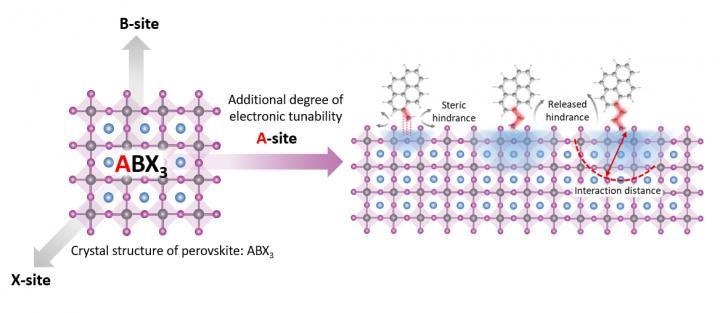Feb 8 2021
Materials scientists from the University of California Los Angeles (UCLA) together with their collaborators have found that perovskites, a family of potential materials that could be used for making economical, high-performance LEDs and solar cells have a hitherto unused molecular component that can additionally tune the electronic property of perovskites.
 Schematic of perovskite material with organic molecules that can add to its electronic properties. Image Credit: Jingjing Xue and Rui Wang/UCLA Samueli School of Engineering.
Schematic of perovskite material with organic molecules that can add to its electronic properties. Image Credit: Jingjing Xue and Rui Wang/UCLA Samueli School of Engineering.
The perovskite materials have been named after Russian mineralogist Lev Perovski and have a crystal-lattice structure of inorganic molecules similar to that of ceramics, together with organic molecules that are interlaced entirely.
To date, these organic molecules seemed to serve only a structural function and could not contribute directly to the electronic performance of perovskites.
Under the guidance of UCLA, a new study illustrates that when the organic molecules are properly designed, they can retain the crystal lattice structure while also contributing to the electronic properties of the materials.
This breakthrough paves the way for new possibilities to optimize the design of materials that will result in improved LEDs and solar cells. The study elaborating the research was published recently in the Science journal.
This is like finding an old dog that can play new tricks. In materials science, we look all the way down to the atomic structure of a material for efficient performance. Our postdocs and graduate students didn't take anything for granted and dug deeper to find a new pathway.
Yang Yang, Carol and Lawrence E. Tannas Jr Professor of Engineering and Principal Investigator, Samueli School of Engineering, University of California Los Angeles
To create a better-performing perovskite material, the team integrated a uniquely developed organic molecule, a pyrene-containing organic ammonium. On its outer part, the positively charged ammonium molecule is related to molecules of pyrene—a quadruple ring of carbon atoms. This molecular design increased the electronic tunability of perovskites.
The unique property of perovskites is that they have the advantage of high-performance inorganic semiconductors, as well as easy and low-cost processability of polymers. This newly enhanced perovskite material now offers opportunities for improved design concepts with better efficiency.
Rui Wang, Study Co-Lead Author and Postdoctoral Scholar, Materials Science and Engineering, University of California Los Angeles
To illustrate the additional effectiveness of the perovskites, the researchers developed a photovoltaic (PV) cell prototype with the materials and further tested it under constant light for 2,000 hours.
The new cell continuously transformed light to energy at 85% of its actual efficiency. This is in contrast to a PV cell developed with the same materials, but without the need for added modified organic molecule, which preserved just 60% of its original efficiency.
The study’s other co-lead authors are Jingjing Xue, a materials science postdoctoral scholar at UCLA, and Xihan Chen of the U.S. Department of Energy’s National Renewable Energy Laboratory (NREL) in Colorado.
The other corresponding authors of the study are Matthew Beard, a senior research fellow at NREL and the director of its Center for Hybrid Organic Inorganic Semiconductors for Energy, and Yanfa Yan, a professor of physics and astronomy at the University of Toledo.
Other authors were from UCLA; NREL; the University of Toledo; Yangzhou University, China; Soochow University, China; Monash University, Australia; and Lawrence Berkeley National Laboratory.
The study was financially supported by the U.S. Department of Energy.
Journal Reference:
Xue, J., et al. (2021) Reconfiguring the band-edge states of photovoltaic perovskites by conjugated organic cations. Science. doi.org/10.1126/science.abd4860.